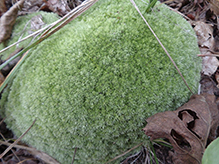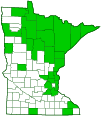pincushion moss
(Leucobryum glaucum)
Conservation • Description • Habitat • Ecology • Use • Distribution • Taxonomy
Conservation Status |
|
|||||||
| IUCN Red List | not listed |
|||||||
| NatureServe | NNR - Unranked SNR - Unranked |
|||||||
| Minnesota | not listed |
|||||||
Description |
||
Pincushion moss is a common, large, tall, tuft-forming moss. It occurs throughout Europe and in eastern North America. It is very common in the eastern United States, and it is common in eastern Minnesota, where it is at the western extent of its range. It is found under partial sun to medium shade in forests, bogs, and swamps. It grows in acidic soil, on rotting logs and stumps, on the bases of trees, and on rock ledges. It is tolerant of disturbance and is often found in cemeteries, in city parks, on trailsides, and in the shade of large buildings. It sometimes forms large cushions up to 40″ (1 m) in diameter. Pincushion moss has an upright grown form (acrocarpous). It forms a large, smooth, dome-shaped, green or light green to whitish cushion on the ground. The cushion is a dense tuft of numerous individual stems that clearly radiate from a central point of origin. The stems are closely packed and difficult to separate. The cushion is usually 1 3 ⁄16″ to 2⅜″ (3 to 6 cm) tall and up to 23⅝″ (60 cm) in diameter, though it may be much smaller. In favorable conditions it can reach up to 5″ (12.5 cm) tall up to 40″ (1 m) in diameter. The stem is anchored to the substrate, dirt or wood, by fibrous filaments (rhizoids). It is green, ⅜″ to 5″ (1 to 12.5 cm) long, round in cross section, and usually unbranched, sometimes evenly (dichotomously) forked. It is densely covered with numerous crowded leaves that arranged almost in whorls. The leaves are erect to spreading, lance-shaped, and ⅛″ to ⅜″ (3 to 9 mm) long. They consist of a broad midrib (costa) with narrow tissue (lamina) on each side. The lamina is only 5 to 11 cells wide. It is widest at the leaf base, narrowing toward the tip. The leaves clasp the stem at the base, and are pointed at the tip. The margins roll inward and the leaf becomes almost tube-like toward the tip. The blades are 4 to 6 cells deep. The inner cells are small and are green because they contain chlorophyll. The outer cells are large, thin-walled, translucent and whitish. They are filled with water when moist, with air when dry. Male and female reproductive organs appear on separate plants within the same cushion. Dwarf male plants grow on tufts of woolly hairs or on the leaves of female plants. Single female reproductive organs (sporophytes) are sometimes produced but are uncommon. The sporophyte consists of a spore-bearing capsule an the end of a slender, reddish, more or less erect, 5 ⁄16″ to 11 ⁄16″ (8 to 18 mm) long stalk (seta). The capsule is 1 ⁄32″ to 1 ⁄16″ (1.5 to 2.0 mm) long, ellipse-shaped, asymmetric, and strongly curved. At the end of the capsule there is an obliquely angled opening. When immature the capsule is light green and the opening is covered with a membranous hood (operculum). As it matures the capsule turns red or reddish-brown, and the operculum breaks apart and drops off, exposing a ring of 16 dark red teeth (peristome). Pincushion moss also reproduces asexually and vegetatively. Small clusters of cells (gemmae) at the tips of the stem are easily detached. Each gemma can form a new plant if it lands on a suitable substrate. If a dried leaf is broken off and moisture is restored, rhizoids will be produced at the tip of that leaf and a new plant will be formed. |
||
Growth Form |
||
Acrocarp |
||
Height |
||
1 3 ⁄16″ to 2⅜″ (3 to 6 cm) |
||
Similar Species |
||
| White moss (Leucobryum albidum) is smaller. The stems are shorter, usually no more than ⅜″ long, rarely more than 1¾″ long. The leaves are shorter, usually no more than ⅛″ long. It is much less common. | ||
Habitat |
||
Moist to moderately dry. Forests, bogs, swamps. Partial sun to medium shade. Acidic soil. |
||
Ecology |
||
|
||
Use |
||
|
||
Distribution |
||||
|
Sources |
|||
| 5/25/2023 | ||||
Nativity |
||||
Native |
||||
Occurrence |
||||
Very common in eastern U.S., common in Minnesota |
||||
Taxonomy |
|||
| Kingdom | Plantae (Plants) | ||
| Division | Bryophyta (mosses) | ||
| Subdivision | Bryophytina (moss) | ||
| Class | Bryopsida (joint-toothed mosses) | ||
| Subclass | Dicranidae | ||
Order |
Dicranales | ||
Family |
Leucobryaceae | ||
Genus |
Leucobryum | ||
Subordinate Taxa |
|||
|
|||
Synonyms |
|||
|
|||
Common Names |
|||
large white-moss leucobryum moss pincushion moss white pincushion moss |
|||
Glossary
Acrocarp
A moss that grows in cushions or tufts; has an upright growth habit; is usually unbranched or sparingly forked; and has the female sporophytes borne at the tips of stems and branches. Adj.: acrocarpous.
Operculum
On mosses: A lid or cover that covers the opening of a capsule and detaches at maturity.
Rhizoid
A filament arising from the lower stem of a moss, liverwort, or alga that anchors it to a substrate.
Seta
A stiff, hair-like process on the outer surface of an organism. In Lepidoptera: A usually rigid bristle- or hair-like outgrowth used to sense touch. In mosses: The stalk supporting a spore-bearing capsule and supplying it with nutrients. Plural: setae. Adjective: setose.
Visitor Photos |
|||||
Share your photo of this plant. |
|||||
| This button not working for you? Simply email us at info@MinnesotaSeasons.com. Attach one or more photos and, if you like, a caption. |
|||||
Luciearl |
|||||
I discovered this fascinating moss on my trail several years ago. I would see it every summer, never spreading and finally breaking down after blowdown and more sun exposure. I can still find part of it in the summer. The texture feels like a tennis ball. Diameter about 18 inches. It first appears as moss on a rock, but when touched it is spongy solid moss. |
 |
||||
MinnesotaSeasons.com Photos |
|||||
|
|||||

Slideshows |
||

Visitor Videos |
|||
Share your video of this plant. |
|||
| This button not working for you? Simply email us at info@MinnesotaSeasons.com. Attach a video, a YouTube link, or a cloud storage link. |
|||
Other Videos |
|||


Created: 1/24/2020
Last Updated:

